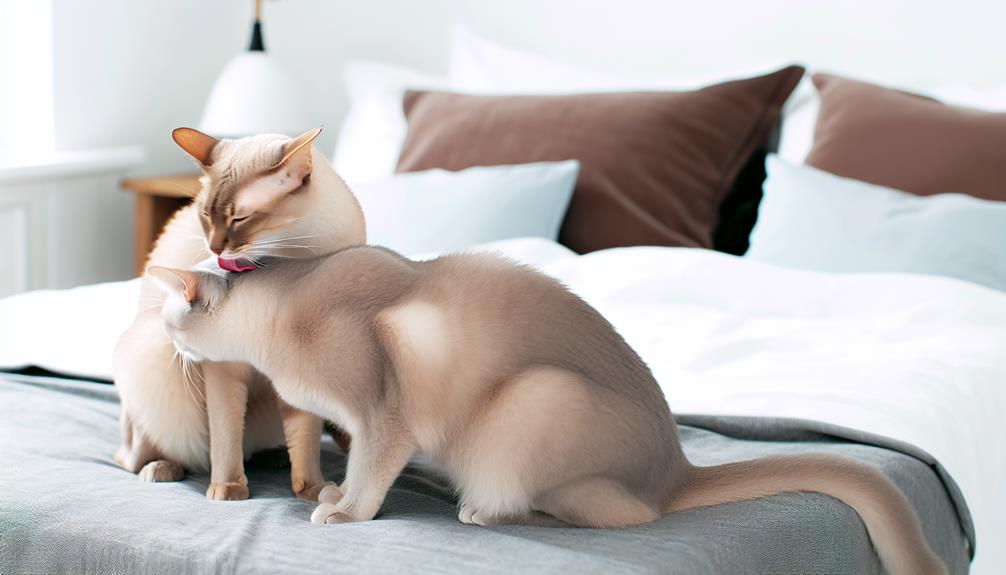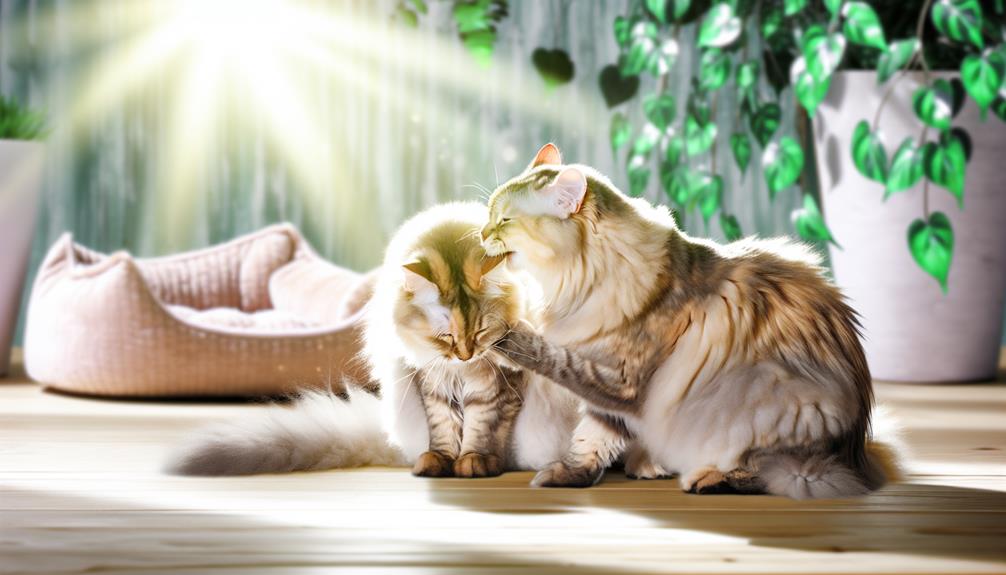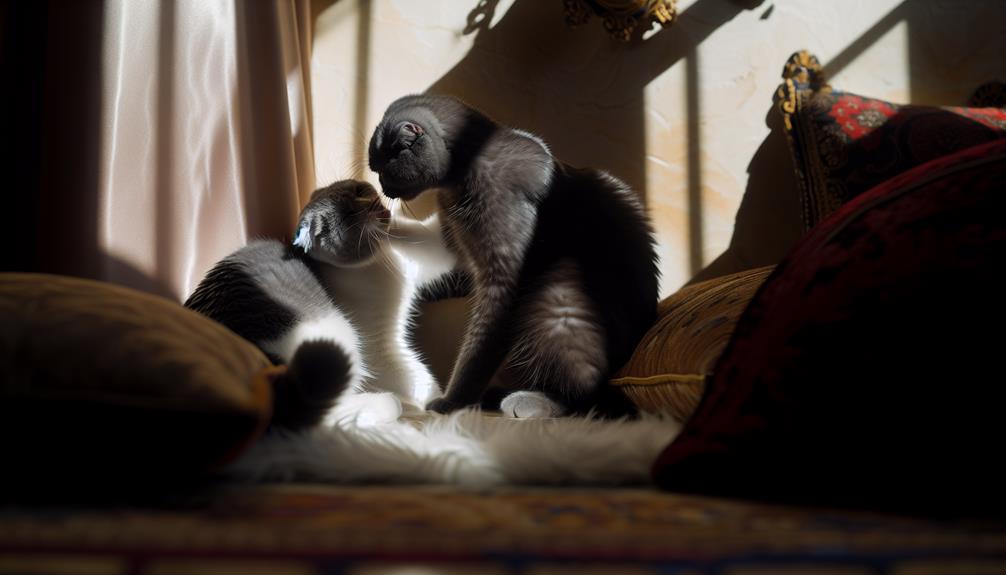Imagine two cats, Luna and Bella, nestled together, grooming each other with meticulous care—it's like watching a well-rehearsed dance. You might wonder why they engage in this mutual grooming ritual. This behavior, known as allogrooming, is more than just keeping clean. It serves significant purposes like reinforcing social bonds and establishing hierarchy within their group. But that's just scratching the surface. There's a lot more to uncover about how these actions impact their emotional well-being and overall health. Curious to know how this simple act can reduce stress among feline friends?
Social Bonding
Engaging in mutual grooming, or allogrooming, is a significant behavior observed in cats that plays an vital role in social bonding. When you see two cats licking each other, it's more than just hygiene; it's a powerful way for them to strengthen their relationship. Cats use allogrooming to express affection and build mutual trust, essential elements in their social structure.
You might notice that allogrooming often happens during or after playful interactions. This isn't a coincidence. Playful activities like chasing and pouncing help cats release pent-up energy and establish a sense of camaraderie. Following these bouts of play, grooming serves as a calming activity that reinforces the bond they've just strengthened through play. It's their way of saying, "I trust you and enjoy your company."
In addition to solidifying social bonds, mutual grooming is a form of communication. Cats have scent glands around their face and by grooming each other, they're exchanging these scents. This creates a shared group scent, which is comforting and reassuring. When your cats groom each other, they're significantly saying, "We belong together."
Moreover, allogrooming helps in stress relief. Just like humans find solace in a hug or a pat on the back, cats find comfort in grooming each other. It's an empathetic gesture that shows they care about each other's well-being.
Understanding the importance of these behaviors helps you appreciate the depth of your cats' relationships. So, when you see your cats engaging in mutual grooming, know that it's a sign of deep-seated mutual trust and affection, strengthened through their playful interactions and shared experiences.
Establishing Hierarchy
While mutual grooming often strengthens social bonds among cats, it also plays a role in establishing hierarchy within a group. When you observe cats engaging in this behavior, you're witnessing more than just affection; it's a subtle, yet significant, dominance display. The cat initiating the grooming usually holds a higher status, while the one being groomed accepts a subordinate role. This interaction helps maintain social order and reduces potential conflicts within the group.
Dominance display through grooming is a way for cats to communicate their standing without resorting to aggressive behaviors. By allowing another cat to groom them, a cat acknowledges the other's higher rank, reinforcing the existing social structure. This is particularly important in multi-cat households or colonies where clear hierarchies can prevent territorial disputes and foster a more harmonious living environment.
Territorial signaling is another aspect of grooming related to hierarchy. When a dominant cat grooms a subordinate, it often leaves its scent on the other cat. This act serves as a marker, indicating to other cats that the groomed individual is part of the dominant cat's territory and under its protection. It's a subtle yet effective way to assert control and manage social dynamics within the group.
Understanding these nuances can help you interpret your cats' behaviors more accurately. Recognizing that grooming is not just about cleanliness or affection, but also about establishing and maintaining hierarchy, can provide valuable insights into their social interactions. This knowledge allows you to better support their natural behaviors, fostering a more balanced and peaceful environment for your feline companions.
Grooming and Cleanliness

You might notice cats licking each other to remove loose fur, which helps keep their coats clean and reduces shedding around your home. This behavior also distributes natural oils across their skin, promoting a healthy, shiny coat. Additionally, mutual grooming plays a vital role in preventing parasite infestations, ensuring both cats stay healthier.
Removing Loose Fur
Cats licking each other is often a meticulous process that serves a practical purpose: removing loose fur. When you observe this behavior, you're witnessing an essential aspect of feline hygiene. Cats have fine, specialized tongues covered in tiny, hook-like structures called papillae. These papillae are adept at catching and removing loose fur, which is particularly important given the dense fur texture of many breeds.
Regular grooming sessions between cats help manage fur shedding and minimize hairballs. The grooming frequency varies between cats, depending on factors like age, health, and environment. Younger cats might engage in more frequent grooming due to higher energy levels, while older cats may require assistance from their companions as their grooming capabilities diminish with age.
You might notice that cats often focus on areas that are harder for their companions to reach, such as the head and neck. This mutual grooming guarantees a thorough removal of loose fur, which not only keeps them clean but also reduces the risk of matting and skin irritations. Understanding this behavior can help you appreciate the intricate social and hygienic dynamics of your feline friends.
Distributing Natural Oils
In addition to removing loose fur, mutual grooming plays a significant role in distributing natural oils across the skin and fur. When cats groom each other, their tongues, which are covered with tiny, backward-facing barbs called papillae, help spread these vital oils. This process guarantees that the fur remains supple and shiny, contributing to a cat's overall health and well-being.
Natural oil distribution is fundamental for maintaining the integrity of a cat's coat. These oils serve multiple functions: they keep the fur waterproof, provide a barrier against environmental contaminants, and help maintain the skin's elasticity. By engaging in mutual grooming, cats are not only keeping each other clean but also supporting each other's skin health.
Feline grooming is a social activity that fosters bonds while making sure that each member of the group remains in peak condition. The act of spreading natural oils through grooming is particularly important because it reaches areas that a cat might not be able to groom effectively on its own, like the head and neck. Consequently, mutual grooming is an essential aspect of feline hygiene and social structure, directly impacting their physical and emotional health.
Preventing Parasite Infestations
Regular grooming plays an important role in preventing parasite infestations among cats. When cats lick each other, they engage in a form of social grooming known as allogrooming. This behavior helps remove loose fur, dirt, and potential parasites like fleas and ticks. By meticulously cleaning each other's fur, cats can enhance their overall hygiene and reduce the risk of parasite transmission.
Flea control is a crucial aspect of maintaining a cat's health. Fleas can cause a range of issues, from skin irritations to more severe conditions like anemia or tapeworm infestations. When cats groom each other, they help guarantee that any fleas present are dislodged and potentially ingested, where the cat's digestive system can neutralize them. This natural flea control mechanism is particularly effective when combined with regular veterinary treatments and preventive measures.
Parasite prevention through grooming isn't just about flea control. Grooming can also help in identifying early signs of other issues such as mites or skin infections. By keeping each other clean, cats can quickly catch and address any signs of trouble. So, while grooming may seem like a simple act of affection, it's a crucial part of your cat's health regimen.
Stress Relief
When you see cats licking each other, it's not just about grooming but also about reducing tension together. This mutual grooming behavior helps soothe social bonds and provides a sense of security. By engaging in this activity, cats can alleviate stress and strengthen their connection.
Reducing Tension Together
Among the many reasons cats engage in allogrooming, one of the most compelling is stress relief. When cats lick each other, they're not just keeping clean; they're engaging in a form of conflict resolution and reinforcing feline communication. This shared grooming helps to decrease tension and create a more harmonious environment.
You might notice your cats engaging in allogrooming during or after situations that could be stressful for them. This behavior has several observable benefits:
- Reduced anxiety: Licking triggers the release of endorphins, which can calm both the groomer and the recipient.
- Social bonding: It strengthens social ties, making cats feel safer and more secure within their group.
- Territory stabilization: It helps establish and maintain a stable social hierarchy, reducing the likelihood of future conflicts.
- Behavioral synchrony: It aligns their behaviors, promoting a sense of unity and shared purpose.
- Improved wellbeing: Physical touch and grooming can reduce overall stress levels, contributing to better overall health.
Soothing Social Bonds
Understanding the role of stress relief in feline interactions can provide deeper insight into why cats engage in allogrooming. When cats lick each other, it's not just about cleanliness; it's an affectionate gesture that strengthens social bonds and reduces stress. These interactions are a form of mutual care where one cat alleviates another's anxiety, fostering a sense of security and trust within the group.
Here's a quick overview of how allogrooming serves as stress relief:
| Aspect | Description | Benefit |
|---|---|---|
| Affectionate Gestures | Gentle licking and grooming | Strengthens social bonds |
| Mutual Care | Caring for each other's well-being | Reduces individual stress |
| Scent Exchange | Sharing familiar scents | Enhances group cohesion |
| Comforting Presence | Physical closeness | Provides emotional security |
Health Benefits

Cats' grooming behavior, often seen as an endearing ritual, actually carries significant health benefits for the feline community. When cats lick each other, they're not just engaging in mutual comfort or feline communication; they're also contributing to each other's well-being in several important ways.
Firstly, grooming helps to maintain skin and coat health. By licking each other, cats remove dirt, loose hair, and parasites that could cause skin irritations or infections. This behavior guarantees that their fur remains clean and their skin healthy.
Additionally, grooming stimulates blood flow to the skin, which can aid in healing and maintaining skin health. The gentle massaging action of a cat's tongue can help to increase circulation, promoting better overall health.
Here are five key health benefits that cats gain from this grooming behavior:
- Parasite Control: Grooming helps to remove fleas and other external parasites, reducing the risk of infestations and associated health issues.
- Wound Care: Licking can help clean minor wounds and abrasions, preventing infections and fostering quicker healing.
- Temperature Regulation: Grooming evenly distributes natural oils across the fur, providing better insulation and aiding in temperature control.
- Stress Reduction: The act of grooming and being groomed lowers stress levels, which can improve immune function and overall health.
- Social Bonding: While not strictly a health benefit, the mutual comfort and strengthened social bonds from grooming can lead to a more harmonious living environment, reducing stress and enhancing overall well-being.
Understanding these health benefits highlights the importance of grooming in the feline world, guaranteeing that your cat remains happy and healthy.
Instinctual Behavior
While the health benefits of grooming are undeniable, this behavior is deeply rooted in a cat's instinctual nature. When your cat licks another feline, it's not just about cleanliness; it's also a reflection of their evolutionary traits and territorial instincts. These behaviors are ingrained and serve multiple purposes that go beyond surface-level grooming.
From an evolutionary standpoint, mutual grooming, or allogrooming, is a trait that has helped cats survive and thrive in the wild. In feral cat communities, grooming each other strengthens social bonds and establishes a sense of unity within the group. This sense of unity is vital for survival, as it fosters cooperation and reduces conflicts among group members. When you observe your cats licking each other, you're witnessing a behavior that has been honed over millennia to promote group cohesion and security.
Territorial instincts also play a significant role in why cats lick each other. By sharing scents through grooming, cats create a communal odor that signifies territorial boundaries. This shared scent is a form of social glue that helps to reduce tension and deter aggression within the group. When your cats groom each other, they're fundamentally marking each other as part of their territory, reinforcing social hierarchies and bonds.
Understanding these instinctual behaviors can help you better appreciate the complexity of your cat's actions. It's not just about hygiene; it's about survival, social structure, and maintaining harmony within their environment. Recognizing these deep-rooted behaviors provides valuable insight into your feline friends' complex social world.
Conclusion
Imagine your cats nestled together, their rhythmic grooming creating a symphony of purrs. This intimate ritual isn't just about cleanliness; it's a cornerstone of their social fabric. Through each lick, they weave trust, establish hierarchy, and alleviate stress. By sharing scents, they foster an environment of harmony and mutual well-being. So, when you see your cats engaged in this tender exchange, remember it's a crucial, instinctual behavior that nourishes their emotional and physical health.
